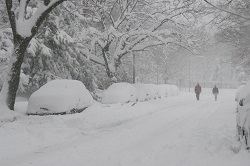This post originally ran on NACCHO’s Healthy People, Healthy Places blog. For more environmental health news and information, visit http://essentialelements.naccho.org/.
By Lindsay Beattie, Program Analyst, NACCHO
 One week away from the start of the winter season, the weather is anything but average for yet another year. This time last year, much of the west saw above average temperatures and below average precipitation, whereas many parts of the east saw record low temperatures and early snowfall. This year is just the opposite. The east is breaking record highs with a margin of up to 30 degrees Fahrenheit, and has yet to see its first snow. Unpredictability is becoming the new normal, making preparedness efforts increasingly difficult.
One week away from the start of the winter season, the weather is anything but average for yet another year. This time last year, much of the west saw above average temperatures and below average precipitation, whereas many parts of the east saw record low temperatures and early snowfall. This year is just the opposite. The east is breaking record highs with a margin of up to 30 degrees Fahrenheit, and has yet to see its first snow. Unpredictability is becoming the new normal, making preparedness efforts increasingly difficult.
To be better prepared during even the most unpredictable seasons, local health departments can use the Centers for Disease Control and Prevention’s (CDC’s) Winter Weather Toolkit to help encourage their communities to take common steps on personal preparedness. Winterizing the home will keep families warm and reduce risks during an extreme winter weather event. Roofs should be checked for any leaks or damage and gutters should be clear in preparation for a heavy snowfall or strong windstorm. People should also insulate water piping that runs along the exterior to prevent freezing. For mobile homes, proper insulation should be installed underneath the flooring as well. Families should store a water and food supply that will not require cooking or refrigeration, along with flashlights and batteries should the power be knocked out. Keep emergency money on hand in the event that power is out for an extended period of time; any store that may be open will not be able to charge cards and ATMs will be down. Make sure the gas tank in cars are full as well, since gas stations will also be out of service. Keep an emergency kit in every car, and always have a plan in place among family members for when an emergency occurs.
The winter season also brings an increased risk for carbon monoxide (CO) poisoning and fires. The most common risk of CO poisoning is improper use of generators. Generators are a great piece of equipment to possess especially if there is a member of a vulnerable population in the household, if medications need to remain refrigerated, etc.; however, they must remain outside and far enough away from the windows so that the fumes will not enter the house. A blocked vehicle tailpipe or a running car inside a garage poses another risk for CO poisoning. Wood burning stoves are common in the winter for many families across the country, in addition to fireplaces. Precautions should be taken to ensure that chimneys and other wood burning outputs are clean and clear prior to use, and there is proper ventilation to decrease health hazards and house fires.
Vulnerable populations are at particular risk as winter seasons become more unpredictable and extreme weather events become more frequent. Sadly, less people are taking the time to know their neighbor and check in on them, especially elderly neighbors living alone. To better serve this population, location mapping is the first key step in order for community officials to ensure their well being during extreme events like severe storms and last year’s polar vortex. Moreover, vulnerable populations do not only include the elderly, young children, and people with disabilities; one population of particular concern is people suffering homelessness. This population generally tries to remain with their possessions, and are sometimes hesitant to go to shelters if they can’t bring their possessions with them, meaning that they are on the streets even during the worst of winter. If possible, local health departments should work with non-profits and other community partners as the emergency shelters are stood up in order to include space for possessions, which may bring in more people. Many counties also have a hypothermia prevention program in place; ensure that community partners know the signs and symptoms of hypothermia and frostbite.
In many parts of the United States this year, planning for winter storms may seem like an unnecessary task, especially with recent predictions that the El Niño phenomenon is still strengthening and will likely last into spring 2016. However, despite its warm trends, El Niño has the possibility to deliver immense amounts of snow—and it has done so in the past. El Niño is a warming of the central and eastern equatorial Pacific Ocean that happens roughly every 2-7 years and lasts between six and 18 months. Scientists do not fully understand what causes the phenomenon. And again, despite its warm veneer, El Niño can bring about a host of severe weather impacts, including flooding and tornadoes.
Encouraging personal preparedness ahead of the season and providing extra care to vulnerable populations will improve community resilience for not only the regular winter season, but for the extreme weather events of which are becoming more frequent with every season. For more information on winter weather preparedness tips, visit:
- Winter Weather Toolbox (NACCHO)
- Winter Storms & Extreme Cold (ready.gov)
- Winter Weather Checklists (CDC)
- Winter Safety (National Oceanic and Atmospheric Administration)








